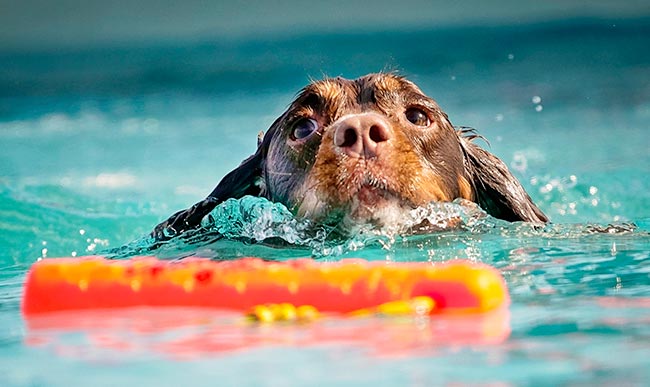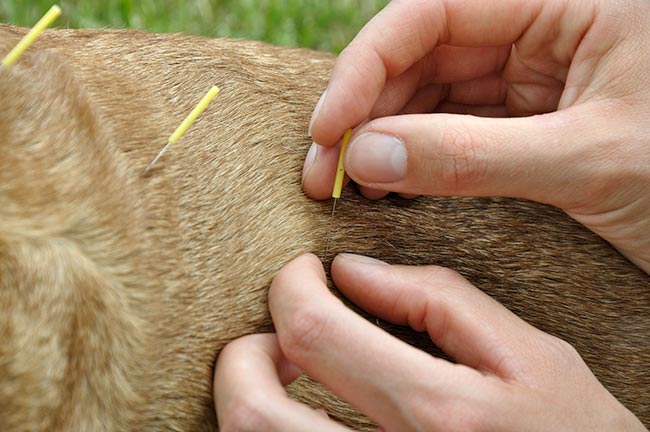18 Dec 2018
This part of Kathryn Cowley's OA series looks at the use of physical therapy and alternative therapies as a way of tackling this condition.

Hydrotherapy can provide a host of benefits. Image © iannnnn / Pixabay
It is well recognised that physical therapies are an important part of rehabilitation for patients suffering from acute injuries and a great tool for management of chronic pain.
With as many as 1.7 million dogs in the UK suffering from OA, both veterinary clinics and therapy centres are seeing huge numbers of patients that would benefit from the combined care of a physical therapist and veterinary professional. Unfortunately, in many cases, a real lack of communication exists between these two sectors – and this is almost certainly having a negative impact on patient care.
For many of us, a reluctance exists to refer to a therapist of non-veterinary training. This may be because of concern that poor treatment could be performed at a physiotherapy or hydrotherapy centre and, as a result of your referral, the owners will place the blame on you or your practice. Perhaps it is due to a lack of understanding of the level of knowledge and training physical therapists have, and how to choose a centre that offers good-quality care.

Hydrotherapists need a level three qualification, which involves a number of theory and practice modules. Unfortunately, no governing body exists, so quality of treatments could vary widely. Get to know the centres close to you and maybe speak with other local practices for their experiences.
If your local centre has therapists who are part of the Canine Hydrotherapy Association or National Association of Registered Canine Hydrotherapists, it is worth bearing in mind treatments carried out by these professionals may be covered by your patient’s insurance policy. The same may not be true for all other professionals in this field, so discuss this with owners prior to referral.
Apart from the obvious benefits of maintaining and strengthening muscles, and improving flexibility in the limbs, hydrotherapy has a host of other potential benefits, including improvement of cardiovascular health and – particularly in the case of underwater treadmills – improvement of gait and proprioception.
Choosing between use of an underwater treadmill or free swimming will depend on the dog’s condition. For example, free swimming may be contraindicated in some cases of lumbosacral disease, but may be better for elbow arthritis than a treadmill.
Physiotherapy requires a higher level qualification, with some courses taken over by universities.
Unlike hydrotherapy, physiotherapy is something we can readily offer in-house. A number of practical or online theory-based courses are frequently advertised as suitable for vets and VNs to get some basic skills under their belt. If this isn’t for you, look for Association of Chartered Physiotherapists in Animal Therapy physiotherapists, who are highly trained and offer a great service to clients.
Physiotherapists will use a combination of massage, joint mobilisation, and strengthening and balance exercises to improve joint flexibility and muscle tone, and reduce inflammation in damaged tissue.
Treatment is most likely to be effective if initiated as soon as possible after injury or diagnosis. A study published in the Journal of the American Veterinary Medical Association has shown, in dogs that received physiotherapy as part of their rehabilitation, a difference in limb function (measured by peak vertical force and vertical impulse) between the repaired and normal limbs was not evident six months after surgery compared to exercise-restricted dogs, where limb function was significantly less in the repaired limb compared to the normal side1. It is not only indicated for postoperative rehabilitation and can be of great benefit to dogs with arthritis, where muscle tone in the affected limbs is compromised.

A host of other adjunctive therapies are also available.
Low-level laser therapy (LLLT) can be carried out in-house, or mobile services are available if you do not have the equipment in your clinic. It is thought to have an analgesic effect, as well as a biomodulatory effect on microcirculation, due to the release of adenosine triphosphate, nitric acid and reactive oxygen from the cells. The initial treatment phase would involve treatment being administered five times over a two-week period, with treatment becoming less frequent – for example, often every two to four weeks.
A growing body of evidence exists for the use of acupuncture for pain treatment in veterinary medicine, and it is a well-recognised treatment modality for painful animals. Acupuncture involves placing needles in specific points on the body to have a healing effect. It can bring improvements to a wide variety of systems in the body, including the muscles bones and joints, hormonal and immune systems, and internal organs.
Actions include improvements in local tissue blood flow, muscle relaxation, distant effects (possibly via fascia), and stimulation of the nervous system to improve the body’s pain control mechanisms. It is particularly useful in the treatment of chronic pain alongside other therapies, such as physiotherapy, hydrotherapy and appropriate pain-relieving medication. Clinical studies have shown positive results in humans and animals.
Practitioners claim acupuncture targets not only the physical, but also the physiological component of pain. It is possible the patient can feel less miserable about its pain, but not necessarily limp less or be able to walk further, which is very challenging to accurately assess. An increasing number of vets are becoming certified in Western Veterinary Acupuncture, so it is likely you can refer to someone in your area. Treatment usually initially consists of four weekly treatments to assess whether it is suitable for the patient, with the aim of reducing treatment frequency according to ongoing patient needs.
Massage therapy is also becoming increasingly recognised as a way of rehabilitating soft tissue injuries and supporting conditions such as arthritis. Therapists require two years of training and must be part of the canine massage guild. With any orthopaedic condition, accompanying muscular issues and pain will occur, and this will often be more widely radiating than the underlying joint pain itself. Massage therapy helps relieve this pain – thereby improving gait, mobility and mood.
Owners are often surprisingly receptive to the suggestion of adjunctive therapies. It is, however, important to ensure – before undertaking any of these treatments – the owner is able to commit to the time needed for the frequent appointments they are likely to be advised, as it will waste both your time and theirs if they can’t.
It is unlikely in most cases that you will be able to withdraw a patient’s conventional analgesics, but they may become less reliant on them with time.